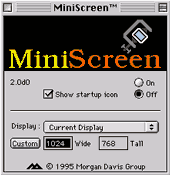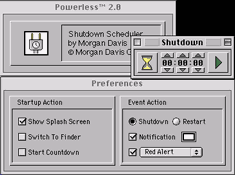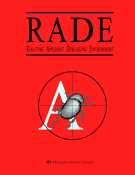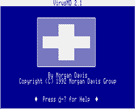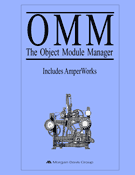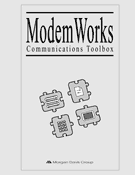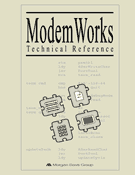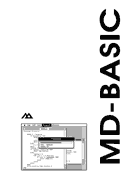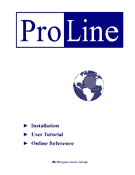MiniScreen
MiniScreen reduces the Mac desktop area to that of a smaller Mac. For example, a 15″ display could be demoted to a nine-incher like on the Mac Plus. I developed MiniScreen for testing applications within the display environment of common Macs. It was great for making sure menu bars and dialog boxes would fit.
The price was $39.95. Among many notable customers, I sold many copies to Microsoft and Apple over the years.
I was working on an application version of MiniScreen before I turned my attention to bigger projects… starting an ISP.
![]() MiniScreen-2.0.sea 27K self-extracting archive
MiniScreen-2.0.sea 27K self-extracting archive
Powerless
The Mac II was one of the first computers to support software-based power-off capability. I wrote Powerless ($19.95) to turn off my Mac at a set time or after a duration. This let me start a time-consuming task (compilation, disk defragmentation, download, etc.) and then have my system shutdown cleanly later.
A new version was being developed when CTSnet came along and stole all my free time. The updated version was an event dispatcher that could shutdown or restart the computer, run an application, play a sound, issue an alert, etc., depending on certain triggers. Triggers included alarm time, countdown timers, idle keyboard or modem activity, etc.
![]() Powerless-2.0.sea 42K self-extracting archive
Powerless-2.0.sea 42K self-extracting archive
RADE
RADE is the Real-time Applesoft Debugging Environment, allowing you to explore the guts of a BASIC program, its variables, program flow, and other runtime characteristics without disturbing the program’s memory or screen display. Without RADE, debugging Applesoft BASIC was intensely frustrating and time consuming. With RADE and its powerful features, like stepping, tracing, and breakpoints, debugging is quick and painless. A relatively proficient programmer, I had to pull out the RADE and exterminate several elusive bugs more than once. The stuff really worked, and it worked well and earned great reviews.
InCider/A+ magazine wrote, “RADE is fast, powerful, full-featured, and easy to use. It’s a breath of fresh air . . . a throwback to the days of tight, efficient programming.”
RADE was a collaborative effort with Russell Gibson. Russ and I conceived and developed RADE during the summer of 1992 with Russ doing the programming, and I did the rest. We split the gross revenue fifty-fifty. Daily electronic mail (via the ProLine network, of course) kept the project rolling. Russ and I met for the first time, face to face, only after RADE and the manual were completed.
RADE was the last Apple II product MDG introduced.
![]() RADE-1.0.img 800K ProDOS disk
RADE-1.0.img 800K ProDOS disk
![]() RADE-1.0.pdf 450K Acrobat file, 48 pages
RADE-1.0.pdf 450K Acrobat file, 48 pages
VirusMD
VirusMD scans an Apple II drive reporting files infected with Apple II viruses, and also offers to fix them. VirusMD repairs damage to volume directories that the viruses cause, and can update your boot blocks if they’re found to be “impure”. This utility sold for $19.95 and included Apple IIGS and 8-bit versions on the disk.
The program landed me an opportunity in 1989 to write an article for A+ Magazine about viruses. After publication, one reader commented in comp.sys.apple2, “As a professional in the computer security game I’d like to publicly complement Morgan Davis on his article in the recent A+ on viruses. It is both well-written and technically accurate.” That was nice to see, as I did not consider myself an expert on computer viruses at the time.
![]() VirusMD-2.1.img 800K ProDOS disk
VirusMD-2.1.img 800K ProDOS disk
Object Module Manager
OMM reminds one of a meditation chant. And in a way, the Object Module Manager (OMM) was a kind of nirvana for me. At the time, object oriented programming (OOP) was the big deal. After wedging a few chunks of machine code into the 48K space along with the operating system, your BASIC code, and its variables, memory management became a nightmare. The OMM created harmony among the growing number of machine language programs needed for fast, efficient 8-bit Apple II applications.
The OMM was the first mechanism to dynamically relocate active code blocks and associated data inside of memory. It allowed you to shuffle code modules on the fly to make the most efficient use of memory. The interface to BASIC applications, which typically would make a CALL to a fixed memory address, was arbitrated by the OMM. So BASIC programs didn’t need to worry about at which address a needed function resided.
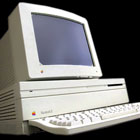
At this point, I created most of my Apple II software on a Mac IIx using cross-platform development tools. It cost $5,000 new, but saved tons of time.
Taking a cue from the OOP hysteria, the OMM supported the concept of message passing. This was required for the OMM to perform dynamic relocation, as modules may want to know when they moved around, especially those employing interrupt handlers. And so a set of messages was developed for such housekeeping chores, including user-defined messages so that developers could create intercommunicating modules.
OMM sold for $39.95. It included an extremely handy module called AmperWorks that added scores of fast and helpful functions to BASIC. Easily the least glamorous of all the “back end” tools that ProLine relied on, the OMM marked a critical evolutionary step. Without it, none of it could have worked.
![]() OMM-1.4.img 800K ProDOS disk
OMM-1.4.img 800K ProDOS disk
![]() OMM-1.4.pdf 317K Acrobat file, 68 pages
OMM-1.4.pdf 317K Acrobat file, 68 pages
ModemWorks
Dan Gookin, famous computer book writer, jokingly called me Modem Davis due to my deep interest in telecommunications. To program modems effectively and make ProLine go, I had to devise a communications toolbox. So ModemWorks was developed.
If you knew 6502 or 65816 assembly language, and had a lot of time on your hands, you could write your own serial port and modem drivers. But most Apple II users wanted a fast and easy solution they could use from BASIC. ModemWorks let them easily turn ordinary BASIC applications into online tools, and took care of all those messy details that made writing modem-based programs a hassle.

In 1984, the Hayes Smartmodem 1200 let you download text faster than you could read it.
Since users had different types of computers and modems, ModemWorks needed easily interchangeable parts that integrated efficiently. This inspired the creation of my Object Module Manager (see below). With a well-documented modular architecture, developers could now easily add their own modules. The ModemWorks Technical Reference (MWTR) guides the advanced programmer through the steps needed to develop custom modules.
According to our sales database (which I wrote in FoxBASE), we sold more copies of ModemWorks than any other product. The credit goes to a headstart from Living Legends Software, an early shareware co-op experiment that I conducted with Jerry Hewett in the early 80s.
Prophetic excerpt from page 6 of the Technical Reference:
Rare disk label. Early copies of ModemWorks were distributed as shareware.
“Let us not believe that even with this new architecture that we will enjoy the cutting edge forever. We may not be communicating using modems in the next eight years. Undoubtedly, new technology will make modems obsolete. Perhaps we’ll connect via high-speed links over direct connections handled for us by the phone (or cable TV?) company. No more Hayes-style AT commands. No more voice-grade lines. We’ll all just network like so many computerized television sets.”
That was written in 1992 long before ISDN, DSL, and high-speed cable were commonplace for Internet access.
![]() ModemWorks-3.1.img 800K ProDOS disk
ModemWorks-3.1.img 800K ProDOS disk
![]() ModemWorks-3.1.pdf 319K Acrobat file, 72 pages
ModemWorks-3.1.pdf 319K Acrobat file, 72 pages
![]() MWTR-3.1.pdf 135K Acrobat file, 40 pages
MWTR-3.1.pdf 135K Acrobat file, 40 pages
MD-BASIC
The trouble with ProLine was that it was written in Applesoft BASIC, the computer language burned into the ROM of every Apple II computer. It was a funky version of BASIC, too, with an arcane line editing mode. Since ProLine was modularized among a hundred BASIC programs, management became difficult. That inspired MD-BASIC, an Applesoft “processor” that resembled a C compiler, complete with directives such as #include and the whole C-like thing.
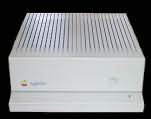
MD-BASIC was written in C (with a little 65816). It ran only on the Apple IIGS but produced BASIC that worked on all Apples
MD-BASIC spruced up Applesoft programs by adding modern constructs such as IF-THEN-ELSE, WHILE-WEND, and support for long, descriptive variable names. Line numbers were now something from the Jurassic period, as MD-BASIC let you use nicely named labels. Plus, it output standard, vanilla Applesoft in a highly compact and optimized format, increasing runtime speed and conserving precious memory. Even better, MD-BASIC let you write your programs in a real text editor, so you could format them properly with copious comments. That was impossible with ordinary Applesoft with its frustrating input mode.
GS+ magazine wrote, “Applesoft may never get better, but writing programs in Applesoft just did. MD-BASIC changes the way people think about Applesoft.”
Like most of my programs, I originally wrote MD-BASIC for me, but realized others would find it just as refreshing and valuable. It was one of our best selling products, retailing for $89.95.
Trivia: An intentional quirk of the MD-BASIC manual is I numbered its chapters by tens, like the old BASIC line numbering technique of yore. Seemed clever at the time.
![]() MD-BASIC-3.0.img 800K ProDOS disk
MD-BASIC-3.0.img 800K ProDOS disk
![]() MD-BASIC-3.0.pdf 500K Acrobat file, 100 pages
MD-BASIC-3.0.pdf 500K Acrobat file, 100 pages
ProLine
ProLine was the first communications product to truly link Apple II computers to the Internet (known as ARPANET back in the mid 1980s). Users connected via modem to exchange email and Usenet news. ProLine was essentially a version of Unix for the Apple II in less than 48K of memory. By the time I was 30, ProLine had consumed a third of my life.
The leading Apple II and Macintosh magazine, inCider/A+, awarded ProLine five full stars in the December 1992 issue, stating, “ProLine is as powerful as many UNIX minicomputer-based systems, yet amazingly, it runs on a standard Apple II. ProLine is top-notch. You can run ProLine as an independent on-line system, but it gains a new world of capabilities if you network it with other systems.”
Hundreds of ProLine systems were scattered around the globe with sites running in every major country. This contribution to computer users of all denominations brought me more pleasure than notoriety or riches.
The highly-respected Boardwatch Magazine (June 1991) admitted, “ProLine is a network of Apple II systems that are not only tied to each other, but routinely carry Internet News Groups . . . something we just didn’t expect. The speed and power of this BBS running on an Apple II were quite impressive.”
ProLine shipped on two 3.5″ 800K disks and originally sold for $259.95 — a lot of money even today for an application. It consisted of scores of BASIC programs that presented a surprisingly accurate Unix-like environment, complete with a scriptable C-shell and online “man” pages. To produce a nice printed manual, I had to learn the PostScript language — an investment that paid off again a dozen years later when it came time to make a PDF file out of the online manual.
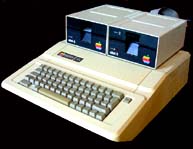
The Apple IIe with 128K -- my first real computer. I had to make ProLine work on an old Apple II+ to run my 24-hour BBS. I later upgraded both machines to the whizzy Apple IIGS.
My own ProLine system, named pro-sol, operated continuously for over 12 years. In the mid 90s, it interfaced via serial cable to a PC running FreeBSD Unix, connected to the Internet via ISDN. Through that box, you could actually telnet into ProLine. I took it down in 1996 when we moved to a new home and decided not to keep it going. Incredibly, some people are still running ProLine systems today, nearly 20 years after its inception.
Excerpt from the author’s personal note on page 4:
“I started writing a BBS for my brand new Apple IIe, because there were no bulletin board systems that supported my modem back then … ProLine introduced me to many friends and acquaintances, some long forgotten, but many who are good friends today. It allowed me to start my own software business, and helped me buy my first home.”
My fondest memory of working on ProLine was in 1984 when Joe Holt, who wrote code for Beagle Bros, Adobe, and now Apple Computer, spent the summer at my house. He stayed up all night hacking away on ProLine, then would turn over his work and notes (in email) to me the next day to continue coding in between college classes. I’d pass the token to him that evening, and on it went for several weeks.
ProLine inspired several other MDG products: ModemWorks, AmperWorks, OMM, and especially MD-BASIC. These started out as technologies used internally, only to be fashioned into commercial-grade, stand-alone products upon which ProLine depended.
![]() ProLine.1.img 800K ProDOS disk
ProLine.1.img 800K ProDOS disk
![]() ProLine.2.img 800K ProDOS disk
ProLine.2.img 800K ProDOS disk
![]() ProLine-3.0.pdf 1MB Acrobat file, 335 pages
ProLine-3.0.pdf 1MB Acrobat file, 335 pages
![]() ProLine source code directory
ProLine source code directory
Brief History of the Morgan Davis Group
Morgan Davis Group
My longtime dream of being a programmer for Beagle Bros, Inc., the coolest Apple software company ever, came true in 1989. But it was not to last. After Beagle was sold to one of its programmers, it was heavy on programming talent, but light on experienced management. The struggling company began laying off employees. The day I was sent home I vowed never again to work for anyone but myself, a promise I would break later (only to ponder again recently).
The best chronicle of my early computer history (including fresh details about Beagle Bros and MDG) is in this GEnieLamp newsletter interview from 1992, posted on the GEnie online service.
So as Beagle was shutting down, the Morgan Davis Group was just booting up. MDG consisted of the three of us (me, myself, and I). Together, we put out several successful products to customers all around the world over a six year period. Here’s how we creatively distributed the labor…
Me, being the technical one, conceived and wrote all the software, including support systems, handled all tech support, and administrated ProLine, our 24-hour BBS. Myself, being semi-creative, managed the marketing, designed, wrote and typeset the accompanying documentation, ad copy, newsletters, and press releases. And, finally, I being the hard-working grunt, developed packaging solutions, copied disks, bound manuals, sorted bulk mailings, boxed quantities of products for retail distributors, and schlepped orders to the post office every day. We each put in an eight-hour shift, or so it felt. We were having great fun — innovating and creating unique, high-quality products like no other schizophrenically-staffed solo company.
Found here are products MDG sold commercially, now available for downloading for free. To learn more about them, click on the manual covers to view them in glorious Adobe Acrobat format.
LEGAL NOTICE: This site contains links to copyrighted software that you may download, use for non-commercial purposes, and give away exactly as-is, provided you include this notice. Modifying copies for others or commercial usage requires written authorization from Morgan Davis.
Interview on GEnie Information Service
GEnieLamp Nov 1992
Who’s Who In Apple II
“””””””””””””””””””””
By Phil Shapiro
[P.SHAPIRO1]
>>> WHO’S WHO? <<<
“”””””””””””””””””
~ A Profile of Morgan Davis ~
~ Creator of the ProLine Bulletin Board System ~
GEnieLamp Morgan, how did you first become interested in programming the
“”””””””” Apple II? Can you remember the specific time and place?
Davis I was a junior in high school (1981), when I had a short one-week
“”””” introductory class on computers. Fortunately, the computer was an
Apple II. That started my (so far) life long interest in them.
GEnieLamp Over the years you’ve created some superlative tele-
“”””””””” communications products (including ModemWorks and ProLine).
Can you tell us a little how you first became interested in tele-
communications? When was the first time you saw the word CONNECT?
Davis Actually, my communications history goes back much farther than
“”””” what you suggest. While in sixth grade, after tiring of only
being able to listen to a short-wave scanner, I wanted to get my amateur
radio operators license, but succumbed a few years later to the easy access
of CB radio. My interest in communications started out in radio.
It was in 1983 when I got my own Apple IIe and had a job writing
books on BASIC programming for CompuSoft Publishing, Inc. They had an
acoustic coupler modem that I was able to take home during the weekends
and connect to the IIe. I would cruise the local bulletin boards for 48
hours and then take the unit back to work on Monday.
Finally, I couldn’t take it anymore and decided I needed a modem I
could use all the time. So, I bought the best modem you could get for the
Apple II series at the time, a Novation Apple-Cat II with a blazing 300bps
throughput and a $400 price tag. I must have been saving my paycheck money
diligently, because it wasn’t too long thereafter when I purchased the
1200bps upgrade option for about $250, as I recall.
The popular external modems at the time were Racal Vadics — very
expensive, very cutting-edge. The Hayes Smartmodem wasn’t in full
popularity until much later. I didn’t have a real Hayes-style modem until
around 1984, perhaps ’85.
Before I had a Hayes-compatible external modem, I had already built an
Apple-Cat-only version of ModemWorks. It was distributed as “shareware” (a
new concept at the time) through a small company a friend and I founded
called “Living Legends Software”. I distributed ModemWorks, ProLine, and a
few other programs through LLS between 1984 and 1988.
On February 14th, 1989, the Morgan Davis Group was created, and I’ve
been selling my own products through it ever since. While the Apple II
market has shrunk over the years, MDG has expanded its product line and
increased revenues each year.
GEnieLamp In the late 1980’s you worked for a year or so at Beagle Bros.
“”””””””” Did your job involve software programming work?
Davis Yes. This is a minor point in history.
“””””
GEnieLamp Was it more along the lines of telephone technical support?
“””””””””
Davis Heck no! 🙂 I was hired in February, 1989 (the same month I
“”””” started MDG) when TimeOut was really enjoying its success. Bert
Kersey had sold Beagle Bros to Mark Simonsen, and Simonsen decided that
he’d like Beagle to become a heavyweight contender in the Macintosh market.
I was hired, along with about six others initially, to work with existing
Beagle programmers (who only had Apple II experience at the time) to create
a product that would dethrone Microsoft Works, Microsoft’s integrated
package with a long, successful history.
Our product, code named Cheetah, was to be designed and developed into
intercommunicating modules that included more features than Works — all in
eight months — a ridiculous timeframe for a group of Apple II programmers,
most who didn’t even own a Macintosh (like myself) and had little or no
experience using one, let alone programming it. From 1984, I had spent a
lot of time working with Macs, but I had only developed software for the
Apple II. I bought a Macintosh IIx through Beagle and paid it off through
my salary over a number of months.
My responsibility in the Cheetah project was to develop the
communications module. Amazingly, I had it getting me online and
transferring data in about two or three months. The hard part, however, was
putting a Macintosh interface on top of it all. Familiar with the serial
port on the IIGS, getting the Mac to speak to a modem wasn’t hard. But
having to learn the other 99% of the Macintosh’s toolbox, operating system,
and development environments took a long time. The other programmers had
similar hurdles to overcome, and many dropped out of the project early on
(Rob Renstrom and Alan Bird, who went on to start WestCode). The team went
from 12 down to about 4 programmers, still holding the same initial feature
list and the same eight-month deadline. Not surprising, we didn’t make it.
GEnieLamp Can you tell us a little about the work environment at Beagle
“”””””””” Bros (formal/informal)?
Davis Beagle was a fun place to work at during the days when it was
“”””” under the fathership of Bert Kersey. On many occasions, I would
stop by at the Beagle offices to visit or drop off a Living Legends product
they might have ordered. It always struck me as the greatest Apple II
company to work for, second only to Apple, of course. I’d love to continue
a happy story, but I’m afraid there isn’t one.
Things were quite different after the TimeOut succe$$. Beagle moved
to an expensive technical park in Sorrento Valley (the Silicon Valley of
San Diego). The atmosphere was casual, but not informal. When I came
aboard, I think they had about 25 employees. There was “management
structure”, company policy manuals, legal agreements to sign, and a
marketing V.P., the only person really overseeing R&D (that was us). Not
at all like the small, attractive company I used to dream of working for.
The Cheetah project lacked serious direction and management. I became
aware of this after long time Beagle programmers, like Randy Brandt,
decided not to be involved with the project. A friend of mine who later
went on to work for Aldus (Silicon Beach at the time), left because of the
pressure and idiocy that went on up in the higher ranks. They had an
insight that I didn’t. After about a year, Cheetah’s team consisted of Joe
Holt (the only accomplished Mac programmer there), Tom Birchall
(experienced at HyperCard, but not application development), and myself.
In the months ahead, Beagle’s employee count atrophied to about 12
following layoff after layoff. There were a few who got out before their
number came up. I stuck with the initial Cheetah plan until April 13 (a
Friday, no less), 1990, when Mark Simonsen called me into his office at the
end of the day and expressed the company’s difficult financial situation,
of which I was all too aware. That was my last day. I went home that
evening in a daze, disappointed that what could have been never happened
after a year and a half. When my good friend Joe Holt heard what happened,
he left Beagle to work for Adobe Systems. I went on to pursue MDG full
time, and have been doing just that ever since.
It’s a real shame. There was amazing talent at Beagle Bros in every
department except the ones that count. We had excellent writers, artists,
an established sales force, awesome Apple II programmers, a few promising
Mac programmers, and everyone (below a certain level) got along expertly.
It just seemed like we were always working against management, or more
accurately, operating under the lack of real management.
To bring a long story to a quick ending, things got worse in the two
years that followed my departure. For months, Beagle operated on a
shoestring with just five or six employees. They sold their Apple II
products to Quality. And then last Friday, they shut down for good. I’m
certain the worsening economy only helped to speed up Beagle’s demise.
GEnieLamp Is Sophie a real dog?
“””””””””
Davis She was (past tense). Sophie left us for Beagle Heaven a few
“”””” years ago.
GEnieLamp Your ProLine bulletin board system has earned an enthusiastic
“”””””””” following with Apple II users and user groups around the
country. In what year was ProLine first released? Can you
describe some of the new features of the latest ProLine
version, ProLine 2.0?
Davis ProLine was first conceived and named in early 1984. It wasn’t
“”””” released until 1985 as a commercial product through LLS. ProLine
2.0 was major upgrade, entailing a nearly total rewrite of the core system.
At the lowest level, I had developed the Object Module Manager to make
ModemWorks 3.0 a reality. This allowed me to create interchangeable
modules for taking care of specific functions, like terminal emulation,
transfer protocols, serial I/O, and so on. ProLine 2.0, mostly written in
Applesoft using MD-BASIC, was able to take advantage of the new features in
ModemWorks by just “recompiling” all the existing code with some new
libraries. So, 2.0 offers additional terminal support (VT-100, 102, 220,
and ANSI), a full complement of protocols (X/Y/ZMODEM), all new online
documentation, and a new 350 page owners manual.
GEnieLamp You run the Morgan Davis Group publishing company with your
“”””””””” wife Dawn. Does running the company take up all your time?
Or are you able to work a separate job as well?
Other than moral support, Dawn doesn’t get too involved in MDG these
days. She’s started her own licensed family day care facility (in our
home–where I no longer keep my office for obvious reasons!). With seven
kids to take care of, she’s pretty busy these days, and loving it.
Running MDG does, indeed, take up ALL of my time. There are always
hundreds of things to do, and it seems like I can’t keep up. Since I write
and develop our products, handle phone support throughout the day, keep up
with online tech support, write and typeset the manuals, handle sales and
marketing, fill orders and shipping, I am PLENTY busy. We’re at that
uncomfortable stage of being too small to hire additional help, but too big
for one person to handle. Somehow, I manage, but I feel the company’s
growth is being retarded due to lack of manpower. How I long for a 36 hour
day, and the endurance to survive one.
GEnielamp After ProLine, your next most popular software product is
“”””””””” probably MD-BASIC, a structured BASIC preprocessor. The
essence of MD-BASIC is that it allows programmers to side-step
the sticky “spaghetti-code” problems inherent in Applesoft
BASIC’s open-ended structure. It’s even possible to write
MD-BASIC programs from within a word processor. Can you tell
us a little about your motivation for creating MD-BASIC?
Davis Actually, our most popular product is ModemWorks, then ProLine,
“”””” and then MD-BASIC. I think MD-BASIC has the potential of being an
extremely successful product, but because of minimal advertising
and practically no magazine coverage, not many people know about
it.
When you market the premier Apple II bulletin board system that
encompasses over 100 BASIC programs, you have a lot of motivation for
improving your Applesoft development scheme! I love the C programming
language, so I took the best features in a C compiler and rolled them into
something that allows you to write BASIC programs in a word processing
environment (that in itself is a far cry from what you have in Applesoft’s
“immediate” programming mode). MD-BASIC’s source files look a lot like
BASIC, C, and Pascal, and when they get run through the MD-BASIC compiler,
extremely compact and efficient Applesoft programs come out.
So you can now write highly structured and well-commented BASIC
programs using a word processor *and* get better results in the end.
MD-BASIC optimizes your code and strips out the dead weight that bloats
most programs written the old, painful way. Its the proverbial “win win”
situation.
GEnieLamp Are there any shareware or commercial software products on the
“”””””””” market that were developed using MD-BASIC?
Davis I know from product registration cards we receive that a lot of
“”””” companies use it. In fact, almost anyone who is doing serious
development work that involves either a little or a lot of Applesoft is
probably using MD-BASIC. Most can’t stop saying good things about it. I
love reading unsolicited endorsements like that here on GEnie.
We, of course, use it for all of our products. We don’t have a single
Applesoft-only product, but almost every disk we put out includes some
short “Startup” program on it which we write using MD-BASIC. It’s easy to
crank out new, impressive programs with it in short order, because you can
easily make use of work you’ve developed in the past by maintaining your
own set of library routines, just like with real high-level languages.
GEnieLamp If it doesn’t violate any confidentiality agreements, can you
“”””””””” tell us if MD-BASIC is being used by any commercial software
publishers?
Davis Of those most GEnie members would recognize, Tom Hoover uses it for
“”””” developing his GEnie Master program. SoftDisk programmers use it.
There are many others. I’d have to open our customer database to find
more.
GEnieLamp Just a few months ago you released yet another BASIC
“”””””””” programmer’s tool, the Real-time Applesoft Debugging
Environment (RADE). Is this tool intended to be used in
conjunction with MD-BASIC? What are the most common
programming bugs that RADE helps overcome?
Davis Since RADE is invaluable for debugging any Applesoft programs, its
“”””” not just for MD-BASIC programmers. It can be used to debug ANY
Applesoft programs. It is even a great educational tool, allowing you to
snoop through programs other people have written. Because of its “stop
action” ability to freeze a running program and let you analyze each
statement as it executes, it is indispensable for discovering and
understanding the tricks accomplished programmers use in their programs.
It’s also indispensable in uncovering those elusive bugs that can’t be
hunted down easily. For example, while a program runs, you can monitor the
flow of execution to see just which statements are being executed. At the
same time, you can watch a set of variables to see how they change in
real-time. You can modify the values of variables while a program runs to
see how that might affect your program. You can look at the program
listing. And you can do all this without having to stop your program or
mess up the screen display. Plus, RADE’s history feature keeps track of
all your debugging operations so you can easily scroll back through them
and find out what might have happened way back when the program first
started running.
RADE is an awesome product that makes the BASIC development cycle a
snap. It’s unobtrusive (takes up just 768 bytes of main memory), it lets
you switch between your program’s display and RADE’s debugging screen to
avoid disturbing your program’s output. It’s great for anyone who programs
in Applesoft.
GEnieLamp Outside of programming the Apple II, what are some of your
“”””””””” hobbies and interests? What do you like to do for fun?
Davis With a family of four and a business like MDG, I don’t have much
“”””” time for myself. However, if, by some fluke of good luck, I do get
some free time, I’ll spend it reading or listening to music — something
truly relaxing. I’m a pretty good racquetball player, so I keep in shape
that way. I spend most of my time on the weekends with my kids. So we do
a lot of outings to places like San Diego’s Zoo and Wild Animal Park, the
Natural History museum, Aerospace Museum, Fleet Space theater and Science
Center, parks, swimming, etc. Lots of stuff kids and grownups both enjoy.
GEnieLamp What is the accomplishment of which you’re the most proud?
“”””””””” What have been the most intriguing experiences for you?
At first, I was going to say that I’m not really proud of any
particular thing. But, I guess I’m proud of all my work, because I’m just
amazed that my stuff works when I complete a project (or think I have
completed one — I don’t think I have yet!). Writing a program and then
documenting it (complete with typesetting) is a long and arduous process.
It can take up to six months for one small project. When you alone work on
one project solid everyday for six months, the tendency to burn out is
prevalent. I’m really happy when we finally get to the shipping stage.
The most intriguing single thing so far was writing a PostScript
generator for ProLine’s online help system. ProLine has always had
command-formatted built in help files which were processed for display on a
computer screen or dot matrix printer. But with ProLine 2.0, I wanted to
be able to ship a manual that included the online documentation in nice
laser printer output. Needless to say, I learned a lot about PostScript,
which I had always feared as being out of my league. It’s pretty cool that
a BASIC program in ProLine can crank out 300 professionally typeset pages
from PostScript code in a manner of minutes. I’m sure there will be
something even more intriguing happening tomorrow.
GEnieLamp As someone who has spent a great deal of time creating
“”””””””” and supporting telecommunications software products, can you
comment a little about the likely future directions of
telecommunications? A recent magazine article said that the
U.S. Postal Service forecasts hard copy mail growing to 250
billion pieces annually before the turn of the century. Rather
than spending huge amounts of money on expanding the current
postal sorting and delivery system, wouldn’t it make more sense
for the U.S. Postal service to subsidize terminals for every
home and business? (Along the lines of the French Minitel
system.)
Davis I think we’re coming to this. Just look at the proliferation of
“”””” FAX machines. To a lesser extent, look at the people who pay
their bills electronically with CheckFree. Granted, CheckFree still
utilizes the postal service, but with direct bank deposits, you’d totally
eliminate the paper. Its the closest thing to owning a Star Trek-like
transporter we have now.
In the communications world of the future, your home address is only
valid for people who need directions to get there and the occasional
parcel package that a computerized shipper, such as UPS and Federal Express
will use. Otherwise, our address will be in the form of computer accounts
or personal access ID numbers that are used to reach us on our portables
(or pen-based systems) wherever we go. The post office won’t provide this
technology. The phone and cable TV companies are more likely to develop
this simply because of their existing roots in communications technology
(fiber optic, cellular, satellite, etc.).
GEnieLamp How can Apple II software developers find out more about your
“”””””””” products?
Simply write or call us at:
Morgan Davis Group
10079 Nuerto Lane
Rancho San Diego
CA 91977-7132 USA
+1 619 670 0563
+1 619 670 9643 (FAX)
+1 619 670 5379 (BBS)
We’re putting together a newsletter, Groupnews, which we’ll be
sending to all of our customers next month. Groupnews talks about our
latest product line and upgrades. We’ll be happy to send a copy to anyone
who is not currently in our customer database by supplying us with a 29
cent postage stamp and their address.
Incidentally, our GEnie address has changed from the difficult to
remember “M.DAVIS42” to the much simpler “MORGAN-DAVIS”.

